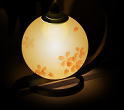
Contents
HOME>MENU>Japanese Children's Books>Summer 2004

| Introduction | The
Japanese Otherworld |
| Classic |
"Kwaidan" |
| Picture Book | "Okkyochan to Kappa" |
| Author | Mizuki Shigeru, Father of the Yokai Manga |
| New English Releases | R.I.C.
Publications Asia |
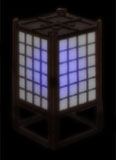

|
The
Japanese love scary stories. Particularly during the summer, we tell or
listen to frightening tales by choice. Stories tailored to chill us to
the bone provide a brief respite from the heat of this blazing hot
season. And there is also something about the Japanese which makes us
very interested in the Otherworld.
Where
does this preoccupation stem from? Religiously, the Japanese tend
to believe that a spirit resides in almost every single object, a
reflection of our Shintoist roots. Sociologically, the Otherworld may
have been exploited to explain away the illogical and unjust aspects of
society, keeping people peaceful and content in spite of hardships.
Japan's natural environment, with four distinct seasons and a landscape
rich in variety, set the scene for a myriad of mysterious phenomena
which could so easily be attributed to Otherworldly forces.
On
the other hand, if we take a look at some of the classical literature
from the middle ages, specifically, "Konjaku Monogatari-shu"
(Tales of Times Now Past) and "Uji Shui Monogatari" (A
Collection of Tales from Uji), it's not uncommon to find that many of
these contain descriptions of evil Oni and Yokai. These "monsters" are
used to mirror human evildoings and laziness, since many of the tales
take the form of moralistic stories. A look at the various illustrated
scrolls and storybooks from the Edo period, show these Yokai and
Spirits to not only be eerie and frightening, but as also having
humorous aspects making them somehow easy to relate to. One could say
they are in some ways almost "human-like". The Japanese think of the
Otherworld as the shadow aspect of this world, without which it could
not be complete. In the same way, Yokai may represent a darker,
alternative aspect of humans. The Japanese therefore have ambiguous
feelings about Yokai, regarding them with both fear and friendliness.
Perhaps this explains why we tend to feel that stories of Yokai and
Ghosts are both "scary but appealing", making us want to hear these
tales every summer.
In
this issue we'd like to present some classic examples of stories and
authors of the Japanese "Otherworld".
Konjaku
Monogatari Shu: "Tales of Times Now Past"
This is a collection of tales compiled sometime at the end of the Heian Era (Beginning of the 12th century AD) and is believed to be one of the most comprehensive and excellent collections of folktales from medieval Japan available. Authors and editors: unknown. The collection includes literature from within Japan as well as translations of tales from abroad totaling over a thousand stories in all. The collection is dividied into three sections based on the country of origin: India (Tenjiku), China (Shintan) and Japan(Honcho). Originally written in 31 volumes. The Kyoto University Library Collection site below shows images of the oldest known copy of these books (National Treasure). Kyoto University http://ddb.libnet.kulib.kyoto-u.ac.jp/exhibit/index.html Konjaku Monogatarishu (Tales of times now past) http://ddb.libnet.kulib.kyoto-u.ac.jp/exhibit/konjaku/kj_top.html Uji Shui Monogatari: "A Collection of Tales from Uji" A
collection of folktales compiled at the beginning of the Kamakura era
(turn of the 13th century). Authors and editors are unknown. Includes
200 stories of life in the Japanese Royal Court, Buddhism as well as
local folktales.
|
 Classic
Classic 
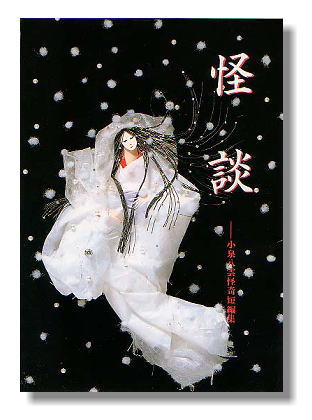
(c) Hiroko Iwashita, 1991
| Kwaidan:
Stories and Studies of Strange Things written by Yakumo Koizumi (Lafcadio Hearn) Project Gutenberg version of the original English text published in 1904 translated into Japanese by Teiichi Hirai Kaiseisha September 1991, ISBN: 4-030651550-0, 735 yen |
|
In
the pursuit of some chills, the Japanese have developed a habit of
telling scary stories during the hot summer months. "Kwaidan" by Yakumo
Koizumi (Lafcadio Hearn) is one of the most popular collections of such
stories. And one of the first scary stories I told my own children was
Hirai's translation of "Kwaidan".
Hirai's
collection contains 19 stories including "The Story of
Mimi-Nashi Hoichi", "Mujina" and "Yuki-Onna". Of course many
translations of "Kwaidan" are available, but Hirai's version is truly
worth savoring. Using language eloquent and richly expressive, it
resounds even more exquisitely when read aloud. The Kaiseisha paperback
reviewed here is an edited version of a translation originally created
for an adult audience. The original translator, Hirai, went over the
text carefully, rewriting portions of it into easier language to ensure
that it could be understood by children still in primary school.
However the dialog remains intact in both versions. Once read, the
audience cannot but help being drawn into the subtlety of this dialog.
My
eight-year-old son asks repeatedly to be told "The Story of
Mimi-nashi Hoichi". Perhaps it's because he first heard this tale
during the summer, but it seems that every summer, he finds this book
on my bookshelf and brings it to me begging, "Please read that story to
me again". Then, remembering "what a terrible experience Hoichi has",
he listens very intently to the tale. My five-year-old son has just
started listening to these stories this year. His favorite is "Mujina"
and he asks, "Tell me the story of the faceless monster again." He also
manages to find this book from its cover, although he can't read yet.
When I first read the story to him he exclaimed, "Oh, it's too
frightening!" and covered both ears, but apparently he still wants to
hear it. His older brother says, "I'm not afraid of this story at all",
but when it starts to get dark out, he says, "Mother, please, whatever
you do, don't say "O-jochu" before we go to bed, okay?" Even I tend to
hesitate reading this book in a dark room. (Readers curious about the
word "O-jochu" may want to check out the e-text version of the original
book.)
Yakumo's
"Kwaidan" is so appealing because these stories are not merely
meant to be frightening. They bespeak the delicate beauty, mystery,
subtlety and quietude of Japan in carefully-wrought language making
them utterly appealing. These are retellings of Japanese classics and
Chinese folktales as well as careful rewritings of traditional horror
stories. Yakumo is said to have struggled diligently, with the help of
his wife Setsuko, to make these stories truly his own. He was known to
have been completely absorbed while writing them. When he was working
on "Mimi-nashi Hoichi", he would refuse to light a lamp even after the
sun had set. When his wife called out to him in a low voice, "Ho-ichi,
Ho-ichi", Yakumo would reply, "Yes, I am a blind man" completely taking
on Hoichi's persona. It's this degree of dedication that makes this
book so facinating. When I read this book out loud, it sometimes seems
almost as if I can hear a second voice. It's almost as if the power of
the language overtakes me and although I am the reader, it seems as if
I am listening to another tell the tales, a phenomenon which sometimes
makes me shiver.
In
your search for some coolness this summer, why not read Yakumo's
Kwaidan?
Yakumo Koizumi (Lafcadio Hearn) 1850-1904 Born
Patrick Lafcadio Hearn in Lefkas, Greece. At the age of 39 he left the
U.S. to come to Japan as a journalist. He soon broke off his contract
as a journalist, and went to teach English at a junior high school in
Matsue city of Shimane prefecture. After he left Matsue, he continued
writing while holding teaching positions at Kumamoto, Kobe and finally,
in Tokyo, while his writing was published in the U.S. He married a
Japanese woman, Setsuko Koizumi, and they had several children after
which he became a Japanese national, changing his name from Lafcadio
Hearn to Yakumo Koizumi. "Kwaidan" is the last of the books which were
published before his death. In September, 1904, he suddenly passed away
as a result of angina pectoris. This year, 2004, is the centennial
anniversary of his demise.
Teiichi Hirai 1902-1976 Born
in Tokyo. He studied British and American literature at Waseda
University, School of Literature, and trained under the poet and
writer, Haruo Sato. For his "Complete Translations of Koizumi
Yakumo's Writings" (Koubun-sha) in twelve volumes, he received the
Japan Translation Award. He is also the translator of Bram Stoker's "Dracula"
(Tokyo Sogensha) among many other books and was involved in bringing
many foreign books of horror and fantasy literature to a Japanese
audience.
|
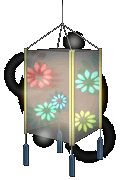 Picture Book
Picture Book 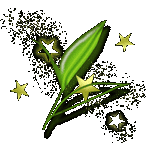
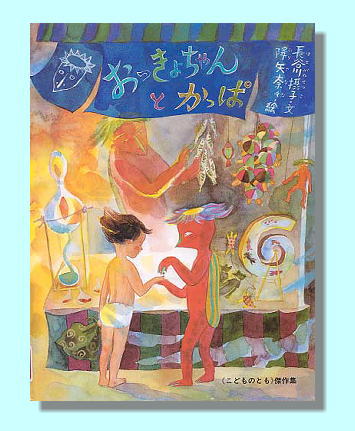
(c) Setsuko Hasegawa, Nana Furiya
| Okkyo-chan to Kappa (Okkyo...one summer's day) written by Setsuko Hasegawa illustrated by Nana Furiya August, 1997, Kodomo no Tomo (Masterpiece Collection) Fukuinkan Shoten, ISBN: 4-8340-1464-9, 840 yen |
|
Once upon a time, there was a little girl named
Okkyo. Her real name was "Kiyo" but everyone called her "Okkyo". One
summer day, she was playing in the river which ran behind her house,
when a Kappa (*) named Gataro suddenly showed up.
"It's the Kappa Festival Day but no one seems
to want to come. You be our guest, okay?"
Okkyo changes into her summer kimono with the
red goldfish pattern, and after wrapping up some cucumbers (a kappa
favorite) in a cloth as a gift for the kappa people, she enters the
water with Gataro.
The festival at the river bottom is bustling
with vendors of all kinds. Stores that sell beautifully colorful
umbrellas, as well as toy and candy stalls. There are street performers
making fish jump through hoops. Kappa are generally depicted as green,
but in this book they're a bright red. The beautiful colors waver in
the water producing a fantasy-like effect. Gataro buys Okkyo a water
pipe for blowing bubbles, shaped like a fish. The kappa are
particularly pleased with her gift of cucumbers, and treat her to some
sweet rice cakes prepared especially for the festival. But once Okkyo
eats these, she forgets first her father, then her mother and finally
everything outside the watery world...
This entrance into the Otherworld suddenly
opens at the edge of a perfectly everyday world. The little girl slips
into the Otherworld when invited, without a second thought. Even for an
adult like me who can't help being concerned about the danger of such
innocence, the exquisiteness and beauteous appeal of the otherworld is
somehow overwhelming and I can't help feeling spellbound as well. By
forgetting everything about where she really belongs, Okkyo becomes one
of the kappa children. Will she ever be able to return to her own life,
the land of humans? As I watch with bated breath, I feel captivated by
the charm of this fantastic world. Before I realize it, I find myself
losing touch with the border between reality and fantasy and may well
discover myself wandering through the story along with little Okkyo.
Like the sound of the river, the story flows
along in a pleasing voice. There's something unusually comforting about
this tale. There's a tinge of nostalgia like reliving a memory of
hearing the sound of fireworks going off in the far distance, or the
drumbeat of taiko. And like a vivid dream, the story is vitally alive.
The beautiful harmony between the text and pictures make for a highly
lyrical and sensitive weaving of a strange tale. Like the soft kindly
glow of the whirling lanterns I used to be able to watch forever on a
long-ago summer's night.
Setsuko Hasegawa 1944- Born in Shimane prefecture. After majoring in French at the Tokyo University of Foreign Studies, she went on graduate school at the University of Tokyo, Faculty of Philosophy but left without graduating to become a nursery school teacher. She later started a private cram school with her husband called "Akamon Juku" and went on to develop an "Akamon Private Children's Library" and "Story Club", becoming increasingly involved with read-alouds and storytelling. She won the 19th Tsubota Joji Literary Prize for best original work and 14th Muku Hotoju Children's Award, as well as the 34th Akai Tori literary award for her short story collection, "Ningyo no tabidachi (The Doll's Farewell)" (Fukuinkan). Her picture books include, "Mekkira mokkira don don" and "Kyodai na Kyodai na" (both in collaboration with Nana Furiya and released from Fukuinkan). Hasegawa has also released two books in France, "Qui est le plus fort" and "L'eau". She presently lives in Saitama Prefecture. Nana Furiya 1961- Born in Tokyo. She studied lithography at the Slovakia Academy of Fine Arts and Design in Bratislava. Her picture books include the above-mentioned collaborations with Setsuko Hasegawa as well as "Tomodachiya" with Rintaro Uchida (Kaisei-sha) . Last year she published a picture book in Slovakia called "Malovana ABCDEDA". She presently lives in Bratislava. (*) Kappa
One of popular types of yokai that live in rivers and lakes. It's usually the size of a human child with webbed extremities and a tortoiseshell on its back. It also has a so-called "dish", a sort of indentation on the top of its head, where it keeps water. Although there are scary stories about kappa dragging oxen and horses into the water or eating the livers of live humans, they are also known as lovable beings that one can't help being fond of.
|
![]()
![]()
![]()
![]()
|
Most Japanese, when they hear the word "Yokai"(*1), will immediately think
of Shigeru Mizuki. In Japan, even those who don't know his name, will
certainly have heard of his famous cartoon character, "Ge Ge Ge no
Kitaro"(*2). The majority of children get their first exposure to yokai through this manga.
Mizuki was born in 1922. From an early age he would
spend many hours visiting a local Buddhist temple, studying the
paintings of heaven and hell displayed there. He was strongly
influenced by their housekeeper, an old woman fondly referred to as
"Non-non-ba" (Granny Non-non(*3)), who was particularly well-educated
in the local folklore. Non-non-ba, who sometimes took on the duties of
a spiritualistic medium for the local community, would fill the little
boy's ears with stories of the wondrous world which lay hidden in the
shadows of the world clearly visible to the ordinary eye. She taught
him that our hearts are supported and nurtured by the souls with which
we come into contact during our lives; souls alive in people and things
both animate and inanimate (*4).
When he grew up, Mizuki was drafted and went to war in
the South Pacific. Suffering many hardships including a narrow escape
from death, he returned to Japan with only a single arm. After
establishing his reputation as the foremost manga artist of yokai, he has since gone on to
expose the truth about the horrors of war in many manga and writings.
Mizuki has traveled far and wide scooping up
references to "unusual beings" of any kind and at any level. He has
studied numerous reference works, ancient paintings and drawings and
has done fieldwork to collect tales and rumors ranging from local
fishwife tales to urban myths, creating a new genre devoted to the yokai. He has drawn manga and
written many encyclopedic works on yokai. Among his drawings of yokai are those which are clearly
influenced by master artists from the Edo period such as Toriyama
Sekien, as well as other drawings which stem from the author's own
ability to see spirits. In fact, Mizuki's depictions are so famous that
many people mistake them for historically accurate portraits of yokai. One of the most outstanding
characteristics of Mizuki's yokai is that in spite of all their horrifying
characteristics, there is something very human and humorous about them.
Yokai are believed to be
representations of various human failings, obsessions and fears
embodied and cannot be totally separated from humans nor can they exist
without humans. When asked to classify his yokai as either good or bad, Mizuki
is said to have replied, "There is no such thing as a bad yokai". For example, the famous
troublemaker in "Ge Ge Ge No Kitaro", known as "Nezumi-Otoko" (or the
rat-man) is clearly not a "benevolent" character but neither is he a
totally bad one either. He's sneaky and often brings trouble to those
around him, but there's something about him that one can't help smiling
fondly at as well. The warmth with which Mizuki views "Nezumi-otoko"
brings to light the multifaceted aspects of yokai, as well as a need for the
generosity to see and accept the many sides present in any being or
phenomena.
Presently 82 years of age, Mizuki has turned his
interest outward towards all unusual doings throughout the world and
continues to communicate his tremendous knowledge, not forgetting his
relentless search and gathering of the macabre for his yokai collection.
*1: Yokai:
The Daijirin dictionary defines yokai as follows: "Mysterious beings or phenomena which are beyond normal everyday experiences and understanding. The more common yokai include Yamanba (mountain ogress), Tengu (crow-like mountain ascetics with huge noses), the one-eyed boy, Sea monster, Kappa and the Snow maiden. Monsters." As these examples show, yokai include aspects of nature or animals stemming from feelings of reverence, as well as personifications of various objects and natural phenomena. Many figures have moralistic value or are humorous. Generally, yokai are considered separate from the "ghosts" which are the spirits of people who have passed away. Anthropological studies of yokai have also popular of late. Generally speaking, however, it is safe to say that there is a tendency to consider Mizuki's collection of yokai as definitive of what constitutes "yokai". 2*: Ge Ge Ge no Kitaro
The last survivor of a non-human race, the little boy Kitaro undertakes various assignments to solve problems relating to yokai. There have been variations in the tone of the story as well as Kitaro's position towards yokai depending on the media and intended audience involved (The animated version of Kitaro is slightly moralistic). Originating as a kamishibai (storytelling using
picture storycards) titled "Kitaro of the graveyard" in the early
sixities, it was released first as a rental manga and later serialized
in Shonen Magazine as "Kitaro of the Graveyard". In 1968 "Ge Ge Ge no
Kitaro" came to the small screen as a TV cartoon series. Newer
animations were produced in 1971, 1985 and 1996. Manga starring Kitaro
have also been serialized in various magazines since that time. There
are also spin-off character goods, amusement park events, video games
and
in addition to a stalwart following from older fans, it continues to
draw new audiences.
*3: "Non-non" means "To pray to the gods and
buddhas"
*4: Oriental beliefs often include the concept of
"animism", the idea that not only humans and animals, but also rocks,
grass, even natural phenomena are "alive" and possess a spirit/soul.
Reference site: Ge Ge Ge News http://www.mizukipro.com/
|
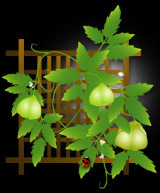
 (C) Keiko Sena, R.I.C. |
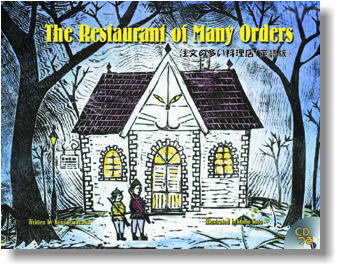 (C) Kunio Sato, R.I.C. |
| Don't Want to Go to
Bed? (Nenai Ko Wa Dareda) Written and Illustrated by Keiko Sena 24 pages, ISBN 4-902216-07-8, 1,200 yen (with CD) The Restaurant of Many Orders (Chumon no Ooi Ryoriten) Written by Kenji Miyazawa Illustrated by Kunio Sato 31 pages, ISBN 4-902216-24-8, 2,200 yen (with CD) Both books translated by Peter Howlett & Richard McNamara |
RIC
continues to add to its list of Japanese picture books in English
translation. Here are two of their titles which just happen to fit the
theme of our "yokai" issue.
First, from Keiko Sena's very popular picture books for babies is "Don't Want to Go to Bed?". "Bong, Bong" rings the clock on the wall. It's nine o'clock. Hey! How come that child isn't in bed? This is a time for ghosts and goblins. Any little child wandering around awake at this time of night is going to be whisked away to the land of the ghosts. You don't need to worry about the danger of "scaring your children to bed" with this little book. The expressive collage work which makes up this and indeed all of Sena's books are so appealing that your children won't be frightened, they'll be begging to have the book read over and over and over again - something likely to delay bedtime in itself. Sena has also published a 15-book series devoted to ghosts and yokai called "Obake Picture Books" (Dojinsha - not yet available in English). Covering traditional yokai such as "Rokurokubi" (long-necked monster) and "Bakeneko" (monster cat), Sena adds a twist to the tale making them appropriate for a younger audience. This, together with the brightly-colored paper collages makes them popular among preschool children and their parents. den. Monsters." As these examples show, yokai include aspects of nature or animals stemming from feelings of reverence, as well as personifications of various object For a much broader audience, "The Restaurant of Many Orders" is R.I.C.'s original rendition of Kenji Miyazawa's famous short story accompanied by Kunio Sato's fabulous wood engravings created especially for this edition. Two young (and rather insensitive) hunters set out with their dogs and guns. Finding no prey, they wander deeper and deeper into the forest. They find an unusual establishment, the RESTAURANT WILDCAT HOUSE (Miyazawa's own naming), and since they're starting to feel hungry, step in for a bite.... One of the translators, Peter Howlett, and the artist, happen to be friends and this project is the fruit of their relationship. Sato's engravings which takes full advantage of the beauty of the wood grain, help to enhance the ambience of Miyazawa's intriguing story of a realistic sojourn into a highly original otherworld. It's certain to fulfill an "order" to leave the reader nicely chilled! Keiko Sena She was born in Tokyo in 1932. After studying under the renowned artist, Takeo Takei, she won the Sankei Children's Book Award for her picture book, "Iyada Iyada no Hon"(Fukuinkan Shoten) ["I Don't Want To!" (also available from R.I.C.)]. She has since published many notable picture books and is one of Japan's most beloved picture book authors. She presently resides in Kanagawa prefecture. Kenji Miyazawa Kenji was born in 1896 in Hanamaki of Iwate Prefecture. After studying at schools in Morioka, he became a teacher at a school of agriculture. A devout buddhist, he was troubled by the plight of the poor farmers and did his best to educate them so that they could rise out of their poverty. With strong interests in literature, philosophy, linguistics, science, agriculture and music, just to name a few, he devoted his life to a study of these and many other subjects. This talented young man wrote many tanka, poems and of course short stories for children such as this one. Tragically, he died in 1933, a mere 37 years of age, from acute pneumonia. Kunio Sato (aka Doktor Wildcat) Doktor Wildcat was born in 1952 in Hokkaido. Working during the day at bookbinding and furniture factories, he went to night school at Toyo University, Department of Buddhist Literature. From the age of 25, he began to create self-taught wood engravings based on Kenji Miyazawa's work which eventually drew notice. He has published several picture books of Kenji Miyazawa's short stories including "Chumon no Ooi Ryoriten" (Dainihontosho) and "Donguri to Yamaneko" (Bennesse). Now firmly established as a leading artist for Kenji's work, he exhibits his art all over Japan. Sato lives in Hakodate. Peter Howlett is a Canadian national born and bred in Japan, Peter teaches English at a Junior High School in Hakodate. He's also very much involved in various environmental protection activities which is how he came to meet Kunio Sato who is also an environmentalist. He is presently the head of the Southern Hokkaido Natural Energy Project. Richard McNamara is a British psychologist and teacher of English at the Prefectural University of Kumamoto. He presently lives in Aso. These two translators have collaborated on many picture books including the Guri and Gura books (Tuttle), as well as "Amy and Ken Visit Grandma" and "Suho's White Horse" (RIC).
|
| (Editor's
Note) It's
one of Japan's hottest summers on record this year, so this issue
should be
particularly welcome. We always try to focus on literature
which reflects the Japanese way of thinking and I feel we've succeeded
in bringing you something quite interesting this time. Hopefully
you've been both chilled and entertained by our Yokai issue! (SI)
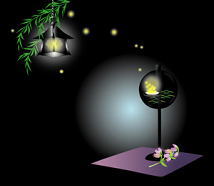 |
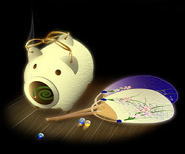 |
Published by: | Yamaneko Honyaku Club |
| Publisher: | Emi Sugimoto (Yamaneko Honyaku Club, Chairperson) | |
| Planning: | Yamaneko Honyaku Club, Staff and Members | |
| Editing and Translation: | Sako Ikegami, Kuriko Mori | |
| Editorial Assistance: | Kyoko
Akatsuka, Yumi Kikuchi, Emi Sugimoto, Mei Takahashi, Midori Takeuchi, Hideko Nakatsukasa, Sakana Hayashi, Reiko Lee |
|
| Cooperation: | Ono Sendai, Literary Translation Network Webmaster |
Please feel free to
address your questions
and opinions regarding Japanese Children's Books to
einfo@yamaneko.org.
We have received express
permission to use
the book jacket images on this page from their respective publishers.
Web images for this page were kindly provided
by the following sites: Suna-no-Utage,
Kaikikurosozai,
Ju-goya, Kagaribigentoh, Meltydark,
Unsuitei, Mugenka-tei.
Reproduction of the
material on this page,
including all articles and images, is strictly forbidden
copyright © 2004 yamaneko honyaku club